The NVIDIA GeForce GTX 970 Review: Featuring EVGA
by Ryan Smith on September 26, 2014 10:00 AM ESTPower, Temperature, & Noise
As always, last but not least is our look at power, temperature, and noise. Next to price and performance of course, these are some of the most important aspects of a GPU, due in large part to the impact of noise. All things considered, a loud card is undesirable unless there’s a sufficiently good reason – or sufficiently good performance – to ignore the noise.
Having already seen GM204 in action with the GTX 980 series, we have a pretty solid foundation to base expectations on for the GTX 970. GTX 970 should offer reduced power consumption at reduced performance, and with EVGA’s open air cooler this card will never hit 80C, so if it is ever throttled it will be entirely by TDP and not by temperatures as was the case with GTX 980.
| GeForce GTX 900 Series Voltages | ||||
| EVGA GTX 970 Boost Voltage | EVGA GTX 970 Idle Voltage | GTX 980 Boost Voltage | ||
| 1.218v | 0.856v | 1.225v | ||
We’ll start as always with voltages, which in this case are in-line with what we have already seen with GTX 980. At 1.218v for the card’s maximum boost bin, the GTX 970 is only a step below the GTX 980 in voltages. We sometimes see these cards binned to operate at lower voltages for power saving purposes, though with GM204’s already low power consumption I’m not sure how necessary that is from a product development standpoint.
Next up, let’s take a look at average clock speeds.
| GeForce GTX 900 Series Average Clockspeeds | |||||
| EVGA GTX 970 FTW | EVGA GTX 970 (Stock) | GTX 980 | |||
| Max Boost Clock | 1418MHz | 1252MHz | 1252MHz | ||
| Metro: LL |
1337MHz
|
1222MHz
|
1192MHz
|
||
| CoH2 |
1265MHz
|
1143MHz
|
1177MHz
|
||
| Bioshock |
1370MHz
|
1221MHz
|
1201MHz
|
||
| Battlefield 4 |
1373MHz
|
1227MHz
|
1227MHz
|
||
| Crysis 3 |
1354MHz
|
1202MHz
|
1227MHz
|
||
| TW: Rome 2 |
1332MHz
|
1177MHz
|
1161MHz
|
||
| Thief |
1329MHz
|
1202MHz
|
1190MHz
|
||
| GRID 2 |
1340MHz
|
1202MHz
|
1151MHz
|
||
| Furmark |
912MHz
|
910MHz
|
923MHz
|
||
Despite not being temperature limited, what we can see right away is that regardless of the clock speed settings it uses, the GTX 970 FTW is TDP limited under all scenarios. At no point in time are we able to maintain the card’s top boost bin, and instead the card spends its time fluctuating between the boost bins it can hold while maintaining power consumption of 145W. The actual drop off from the maximum boost bin depends heavily on the game; some games average clock speeds close to the maximum, while others have to pull way back.
Overall the GTX 970 FTW is a bit more TDP limited in its factory overclocked FTW configuration than its reference clocked configuration, as higher clock speeds draw greater power levels even though voltages are constant. Otherwise we find that in the FTW configuration the card is on average clocked 138MHz higher than the reference configuration, which isn’t quite as high as the 166-189MHz difference in their official specifications. In other words, the FTW’s performance advantage is equivalent to a 140MHz overclock.
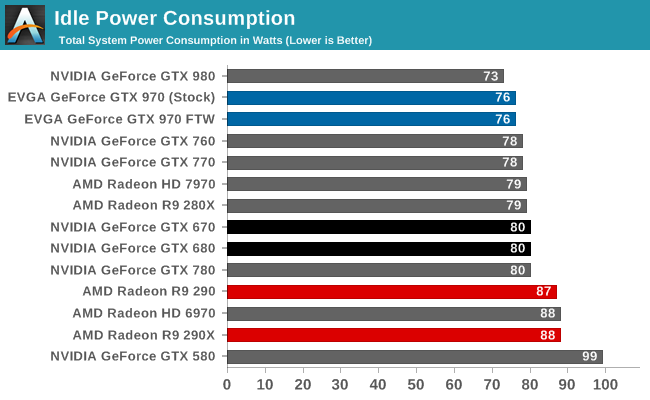
Moving on to power and starting with idle power consumption, the GTX 970 FTW does not fare quite as well as the GTX 980. Despite having fewer SMMs lit up, EVGA’s card draws a consistent 3W more at the wall. In lieu of other data it’s difficult to determine exactly whether this is due to chip-to-chip variation or EVGA’s board, but the latter explanation is more plausible at this moment.

Load power consumption for GTX 970 follows the same path as the GTX 980, almost down to the watt in this case. The GTX 970 FTW actually sees slightly higher power consumption at the wall, while reducing it to reference clocks brings down the power consumption to a flat 300W. Since we are underclocking a factory overclocked card I’m not going to read into the underclocked results too much, but for the FTW we’re looking at power consumption similar to GTX 980 but not quite the performance to match. This is likely thanks to the GTX 980 operating a bit under its TDP due to thermal throttling.
Still, GTX 970 FTW remains as one of the lower power consuming cards of anything in our lineup. Similarly performing cards such as the GTX 780 and Radeon R9 290XU (which is virtually tied on performance here) clearly draw more power, significantly so in the case of the latter.
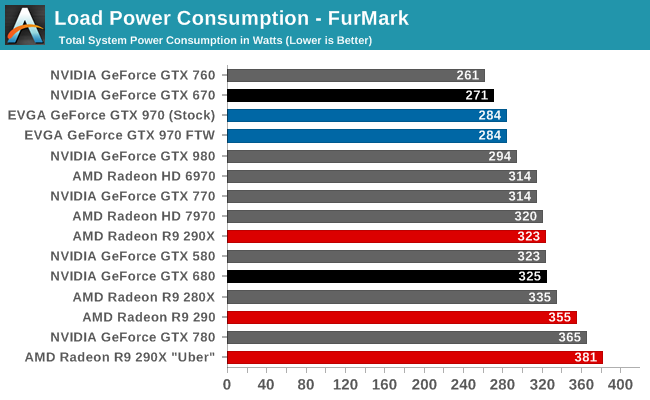
The story is much the same with FurMark. Since this a purely TDP limited scenario the GTX 970 FTW configuration draws 284W at the wall regardless of the clock speed settings used. In this worst case scenario power consumption is 10W less than the GTX 980 at the wall and 71W less than AMD’s R9 290. Meanwhile since the GTX 970 is TDP limited under all gaming workloads, in this case this is not a bad proxy for overall power consumption while gaming.
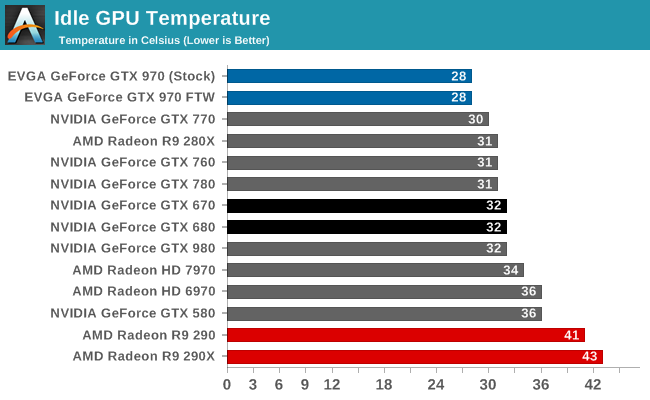
While idle power consumption didn’t quite top the charts, idle temperatures do. At 28C the GTX 970 FTW is barely above room temperature.
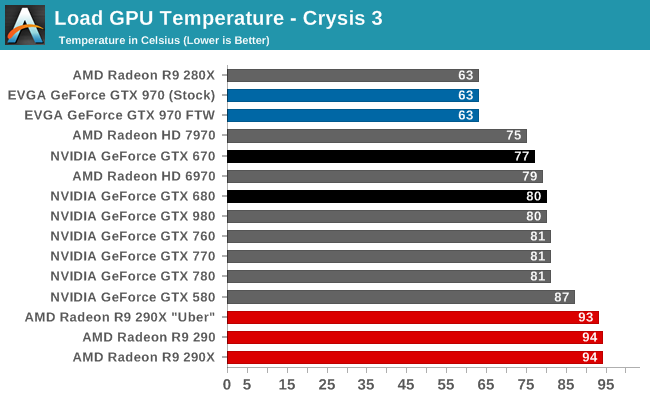

Owing to its open air cooler, low TDP, and TDP throttling, the load temperature for the GTX 970 FTW tops out at 63C in all scenarios. Whether it’s gaming or FurMark, 100% TDP means the card finds its cooling/temperature equilibrium at nearly 20C less than its thermal throttling point.
In this case since this is one of the only open air coolers in this lineup – the only other card was the R9 280X – this means the GTX 970 FTW tops the charts thanks to its design. We’ve already covered the pros and cons of open air coolers many times before, and when it comes to temperatures this is a definite pro.
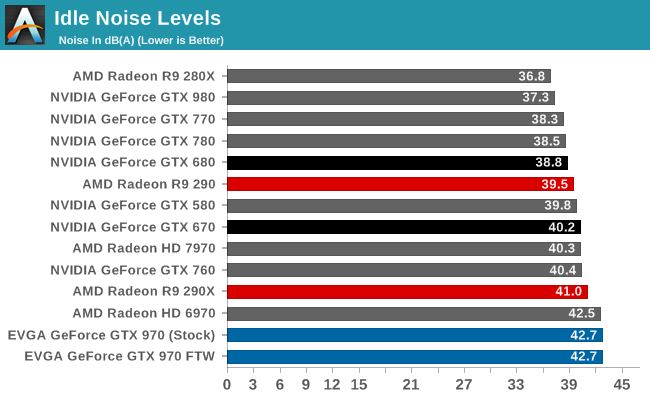
If there is an Achilles heel for the GTX 970 FTW then it is idle noise levels. EVGA’s ACX 2.0 cooler just doesn’t idle very well; even at its minimum fan speed, it still pushes enough air to push the sound meter to 42.7 dB. At this noise level the GTX 970 FTW is not in terrible shape, but near-silent at idle it is not. As it currently stands this card is not going to be a great choice for users looking for a system that can idle with little noise, especially compared to some of the 38dB cards we’ve seen over the last year.
This I suspect is why EVGA is looking into changing their card over to using passive cooling at idle. If EVGA can successfully pull off that modification and turn off the fans when idling, then they will resolve the card’s one true weakness and go from the bottom of this chart to the top.
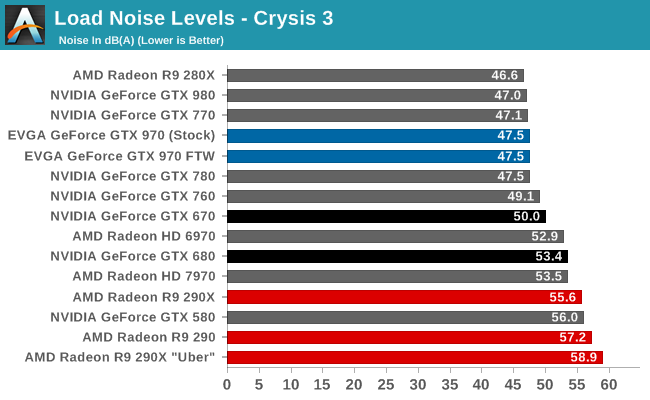
Truth be told, even load noise levels aren’t all that impressive here. 47.5dB is still near the top of our charts, but the GTX 980 of all things ended up being ever so slightly quieter. Which perhaps more than anything else goes to show just what that $550 price tag is paying for when it comes to cooling.
Without more GTX 970 cards it’s hard to place EVGA’s card among its true competition. But given what we’ve seen previous 150W cards do in the past, it’s safe to say that EVGA is running a bit loud at both idle and load for the amount of heat they have to remove. I suspect the ACX 2.0 cooler used here is a bit oversized for a 145W card, which is similarly reflected in the low temperature results. Given the kind of power they have at hand, EVGA could likely do better with a more conservative fan curve.
Looking at the broader picture, while EVGA may not do well against other open air coolers, they are going to do well against most other blowers here. Even the GTX 670 is louder, with a 2.5dB difference in EVGA’s favor.
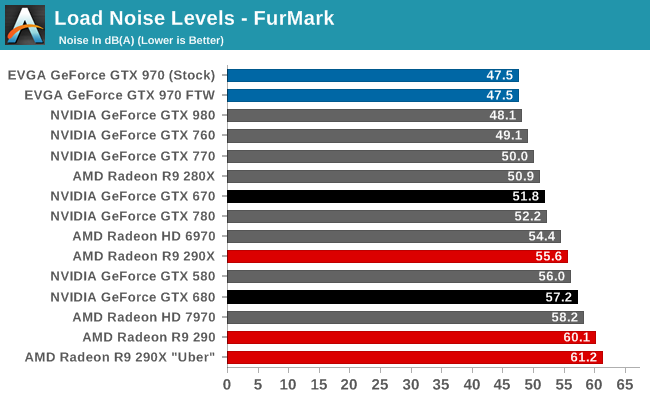
When it comes to FurMark the GTX 970 FTW goes to the top of our charts, but it remains within a stone’s throw of the GTX 980.
Overall the GTX 970 FTW is a bit of a mixed bag. EVGA’s aggressive fan curve and ACX 2.0 cooler produce some amazing GPU temperatures, even for a 145W card. On the other hand EVGA’s noise levels are simply so-so for an open air cooler, with EVGA benefitting from most of the competition in our charts being louder blowers.
To be clear it’s still a solid performance and 47.5 dB for the second fastest single-GPU card on the planet is incredibly quiet. I don’t even have to throw in an R9 290XU comparison to make that point, though that card is AMD’s closest competitor from a gaming performance standpoint. Still, I only wonder how well other open air coolers could do in this situation given what we’ve seen from other cards in the past. If nothing else, perhaps we’ve been spoiled by the GTX 980 and its top-tier blower.
Update 9/26: Though EVGA missed the initial cut-off for this review, later in the day they turned in an beta/engineering version of their upcoming vBIOS with the zero fan speed idle changes worked in, along with a new fan curve. We can confirm that the zero fan speed function is working in this BIOS, rendering the card silent at idle.
Overall EVGA is keeping the fans off until about 63C, at which point the fan controller starts ramping up the fans until it finally supplies enough power for them to kick in. Even under a max TDP load (FurMark) the fans are up and running by 67C.
At the same time EVGA’s new fan curve has adjusted their equilibrium point from 63C to 73C. At max TDP load our card now tops out at 73C, which corresponds to a fan duty cycle of 29%, or 42dB. This new curve places the fan load noise levels at less than the previous curve’s idle levels, and now makes this one of the quietest midrange enthusiast cards we have ever reviewed.
| EVGA ACX 2.0 Cooler Performance | ||||
| Shipping BIOS | Engineering BIOS | |||
| Idle Fan Speed | 30% | 0% | ||
| Load Fan Speed |
38%
|
29%
|
||
|
|
||||
| Idle Temperature |
28C
|
33C
|
||
| Load Temperature |
63C
|
73C
|
||
|
|
||||
| Idle Noise |
42.7dB
|
36.3dB
|
||
| Load Noise |
47.5dB
|
42.0dB
|
||
For the time being this BIOS is still under development (and is subject to change), with EVGA telling us that their goal is to release it to users in the “coming weeks.” Since this BIOS is still in development and not available to the public we will not be changing our official results, but it certainly warrants a proper second look once EVGA ships this BIOS.


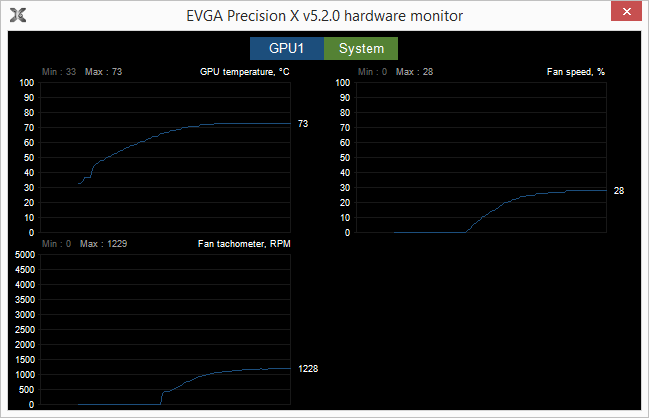








155 Comments
View All Comments
Casecutter - Friday, September 26, 2014 - link
I’m confident in if we had two of what where the normal "AIB OC customs" of both a 970 and 290 things between might not appear so skewed. First as much as folks want this level of card to get them into 4K, there not... So it really just boils down to seeing what similarly generic OC custom offer and say "spar back and forth" @2560x1440 depending on the titles.As to power I wish these reviews would halt the inadequate testing like it’s still 2004! The power (complete PC) should for each game B-M’d, and should record in retime the oscillation of power in milliseconds, then output the 'mean' over the test duration. As we know each title fluctuates boost frequency across every title, the 'mean' across each game is different. Then each 'mean' can be added and the average from the number of titles would offer to most straight-forward evaluation of power while gaming. Also, as most folk today "Sleep" their computers (and not many idle for more than 10-20min) I believe the best calculation for power is what a graphics card "suckles" while doing nothing like 80% each month. I’d more like to see how AMD ZeroCore impacts a machines power usage over a months’ time, verse the savings only during gaming. Consider gaming 3hr a day which constitutes 12.5% of a month, does the 25% difference in power gaming beat the 5W saved with Zerocore 80% of that month. Saving energy while using and enjoying something is fine, although wasting watts while doing nothing is incomprehensible.
Impulses - Sunday, September 28, 2014 - link
Ehh, I recently bought 2x custom 290, but I've no doubt that even with a decent OC the 970 can st the very least still match it in most games... I don't regret the 290s, but I also only paid $350/360 for my WF Gigabyte cards, had I paid closer to $400 I'd be kicking myself right about now.Iketh - Monday, September 29, 2014 - link
most PCs default to sleeping during long idles and most people shut it offdragonsqrrl - Friday, September 26, 2014 - link
Maxwell truly is an impressive architecture, I just wish Nvidia would stop further gimping double precision performance relative to single precision with each successive generation of their consumer cards. GF100/110 were capped at 1/8, GK110 was capped at 1/24, and now GM204 (and likely GM210) is capped at 1/32... What's still yet to be seen is how they're capping the performance on GM204, whether it's a hardware limitation like GK104, or a clock speed limitation in firmware like GK110.Nvidia: You peasants want any sort of reasonable upgrade in FP64 performance? Pay up.
D. Lister - Friday, September 26, 2014 - link
"Company X: You peasants want any sort of reasonable upgrade in product Y? Pay up."Well, that's capitalism for ya... :p. Seriously though, if less DP ability means a cheaper GPU then as a gamer I'm all for it. If a dozen niche DP hobbyists get screwed over, and a thousand gamers get a better deal on a gaming card then why not? Remember what all that bit mining nonsense did to the North American prices of the Radeons?
D. Lister - Friday, September 26, 2014 - link
Woah, it seems they do tags differently here at AT :(. Sorry if the above message appears improperly formatted.Mr Perfect - Friday, September 26, 2014 - link
It's not you, the italic tag throws in a couple extra line breaks. Bold might too, I seem to remember that mangling a post of mine in the past.D. Lister - Sunday, September 28, 2014 - link
Oh, okay, thanks for the explanation :).wetwareinterface - Saturday, September 27, 2014 - link
this^you seem to be under the illusion that nvidia intended to keep shooting themselves in the foot forever in regards to releasing their high end gpgpu chip under a gaming designation and relying on the driver (which is easy to hack) to keep people from buying a gamer card for workstation loads. face it they wised up and charge extra for fp64 and the higher ram count now. no more cheap workstation cards. the benefit as already described is cheaper gaming cards that are designed to be more efficient at gaming and leave the workstation loads to the workstation cards.
dragonsqrrl - Saturday, September 27, 2014 - link
This is only partially true, and I think D. Lister basically suggested the same thing so I'll just make a single response for both. The argument for price and efficiency would really only be the case for a GK104 type scenario, where on die FP64 performance is physically limited to 1/24 FP32 due to there being 1/24 the Cuda cores. But what about GK110? There is no reason to limit it to 1/24 SP other than segmentation. There's pretty much no efficiency or price argument there, and we see proof of that in the Titan, no less efficient at gaming and really no more expensive to manufacture outside the additional memory and maybe some additional validation. In other words there's really no justification (or at least certainly not the justification you guys are suggesting) for why the GTX780 Ti couldn't have had 1/12 SP with 3GB GDDR5 at the same $700 MSRP, for instance. Of course other than further (and in my opinion unreasonable) segmentation.This is why I was wondering how they're capping performance in GM204.